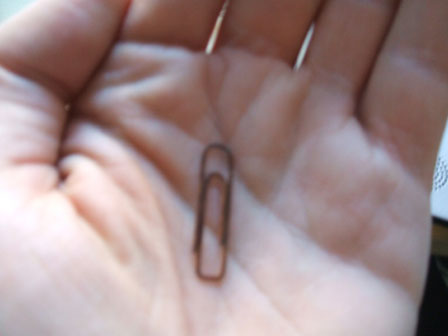Januar 18, 2009
Norwegian invention? The Paper Clip

North is back from its unplanned hiatus (I was recording music: a still-unfinished Dacianos innspilling) and I type this as parked cars disappear beneath the white blankets of snow and the air is filled with small white angels falling in heavenly silence. Or something. Anyhow, as the winter bites and the outskirts of the city fall prey to Polar Bear attacks, I fearlessly report to you, my worldwide readership, on one of the most controversial subjects in Norwegian culture: the invention of the paperclip.
Aye, the paperclip. Binders it's called in Norwegian. Why is it so important to Norway? There was a 7-metre paperclip erected as a monument to it in 1989, Norwegian patriots during the Nazi occupation wore paperclips in the 1940s, and I even found a paperclip in the shower the other day. The paperclip lies at the heart of the Norwegian experience - yet there is great uncertainty about it. The Norwegian-ness of the object is shrouded in considerable doubt.
Norwegian inventor Johan Vaaler (1866-1910) was granted a patent in Germany and the USA for a paperclip in 1901. His invention, however, had only one turn of the wire, so was far less ingenious than the paperclip we have today, which has two turns. In fact Vaaler's paperclip was never manufactured.
The two-turn paperclip we know and love was actually never patented. According to the relevant article on Wikipedia, 'it was most likely in production in Britain as early as 1890 by "The Gem Manufacturing Company"'. Wikipedia's article goes on to state that 'Definite proof that the modern type of paper clip was well known in 1899 at the latest is the patent granted to William Middlebrook of Waterbury, Connecticut on April 27 of that year for a "Machine for making wire paper clips". The drawing clearly shows that the product is a perfect clip of the Gem type.'
That didn't stop Norwegians from believing that Vaaler was the unsung hero of the paperclip, and Norwegian books stated this simply as a fact. This happened in the 1950s, after World War II. The wearing of the paperclip in lapels as a symbol of national unity under the Nazi occupation came first. The occupiers would not allow people to wear flag pins, so the humble paperclip, symbolizing the 'binding' of the Norwegian people together, seemed like a good replacement. The Norwegianization of the paperclip thus happened before the claim to having invented it was ever promulgated. The occupation is also the origin of the emotional connection between these northern tribes and their totem clip.
Ironically, 'Operation Paperclip' was the name the Americans gave to their whisking away of Nazi rocket scientists and nuclear physicists to the USA for future use in the the evils of the Cold War.
So now you know.
Contact Me
Posted by barry at Januar 18, 2009 10:33 EM

post<li> - Post to Social Networking Sites
